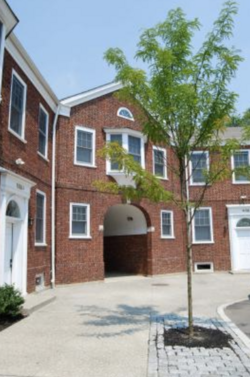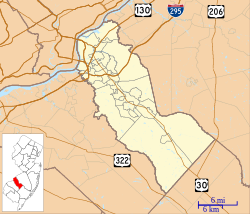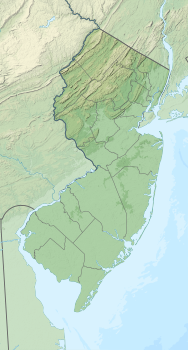
The New York Shipbuilding Corporation was an American shipbuilding company that operated from 1899 to 1968, ultimately completing more than 500 vessels for the U.S. Navy, the United States Merchant Marine, the United States Coast Guard, and other maritime concerns. At its peak during World War II, NYSB was the largest and most productive shipyard in the world. Its best-known vessels include the destroyer USS Reuben James (DD-245), the cruiser USS Indianapolis (CA-35), the aircraft carrier USS Kitty Hawk (CV-63), the nuclear-powered cargo ship NS Savannah, and a quartet of cargo-passenger liners nicknamed the 4 Aces.

The United States Shipping Board (USSB) was established as an emergency agency by the 1916 Shipping Act, on September 7, 1916. The United States Shipping Board's task was to increase the number of US ships supporting the World War I efforts. The program ended on March 2, 1934.

Hog Island is the historic name of an area southeast of Tinicum Township, Pennsylvania, United States, along the Delaware River, to the west of the mouth of the Schuylkill River. Philadelphia International Airport now sits on the land that was once Hog Island.

The Emergency Fleet Corporation (EFC) was established by the United States Shipping Board, sometimes referred to as the War Shipping Board, on 16 April 1917 pursuant to the Shipping Act to acquire, maintain, and operate merchant ships to meet national defense, foreign and domestic commerce during World War I.

The Federal Shipbuilding and Drydock Company was a United States shipyard in New Jersey active from 1917 to 1948. It was founded during World War I to build ships for the United States Shipping Board. Unlike many shipyards, it remained active during the shipbuilding slump of the 1920s and early 1930s that followed the World War I boom years. During World War II, it built merchant ships as part of the U.S. Government's Emergency Shipbuilding program, at the same time producing more destroyers for the United States Navy than any yard other than the Bath Iron Works. Operated by a subsidiary of the United States Steel Corporation, the shipyard was located at Kearny Point where the mouth of the Hackensack River meets Newark Bay in the Port of New York and New Jersey.

South Camden is a neighborhood in Camden, New Jersey. Located in the southern part of the city, below Central Waterfront and east of the Port of Camden on the Delaware River. Interstate 676 runs through the neighborhood.
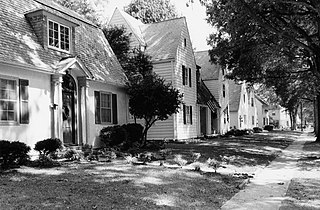
Hilton Village is a planned English-village-style neighborhood in Newport News, Virginia. Recognized as a pioneering development in urban planning, it is listed on the National Register of Historic Places. The neighborhood was built between 1918 and 1921 in response to the need for housing during World War I for employees of Newport News Shipbuilding & Drydock Company. It is recognized as the United States' first Federal war-housing project.

The Alameda Works Shipyard, in Alameda, California, United States, was one of the largest and best equipped shipyards in the country. The only building remaining from the yard is the Union Iron Works Powerhouse, which is listed on the National Register of Historic Places.1956.
The Pusey and Jones Corporation was a major shipbuilder and industrial-equipment manufacturer. Based in Wilmington, Delaware, it operated from 1848 to 1959.
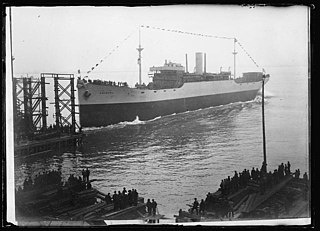
The Merchant Shipbuilding Corporation was an American corporation established in 1917 by railroad heir W. Averell Harriman to build merchant ships for the Allied war effort in World War I. The MSC operated two shipyards: the former shipyard of John Roach & Sons at Chester, Pennsylvania, and a second, newly established emergency yard at Bristol, Pennsylvania, operated by the MSC on behalf of the U.S. Shipping Board's Emergency Fleet Corporation (EFC).
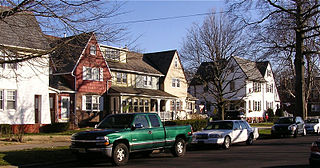
The Harriman Historic District is located in the northern section of Bristol, Pennsylvania, United States. It is a 17-acre (6.9 ha) residential area with 109 buildings, mostly houses, and the local secondary school.
Electus Darwin Litchfield, FAIA (1872–1952) was an American architect and town planner, practicing in New York City. His firm, Electus D. Litchfield, established in 1926, practiced at 80 Fifth Avenue until he disestablished it in 1950.

The Port of Camden is situated on east bank of the Delaware River in Camden and Gloucester City in southern New Jersey. It is one of several ports in the Delaware Valley metro area port complex and is located near the mouth of Newtown Creek opposite the Port of Philadelphia. The port is one of the nation's largest for wood products, steel, cocoa and perishable fruit.

The Atlantic Heights Development is a historic company-built worker subdivision in Portsmouth, New Hampshire. Bounded by I-95, the Piscataqua River, and the tracks of the Boston and Maine Railroad, this small neighborhood was built in 1918–1920 to meet housing demand for workers at the Atlantic Company Shipyard, located just to the south, and served as a prototype for later residential subdivisions. It was listed on the National Register of Historic Places in 2006.

Todd Pacific Shipyards, Los Angeles Division was a shipyard in San Pedro, Los Angeles, California. Before applying its last corporate name, the shipyard had been called Los Angeles Shipbuilding & Dry Dock Company and Todd Shipyards, Los Angeles Division. Under those three names, the San Pedro yard built at least 130 ships from 1917 to 1989.
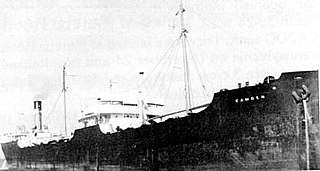
SS Camden was an American 6,653-ton tanker built by the New York Shipbuilding Company of Camden, New Jersey, for the Charles Kurz & Co. Inc. of Pennsylvania Shipping Company. She was operated by Shell Oil Company of Wilmington, Delaware. She was launched in 1921. The ship became famous when it was torpedoed early in World War II off the West Coast of the United States off Coos Bay, Oregon, at 43.38 N, –124.48 W at 7:00 am. She had departed San Pedro, Los Angeles, California, to Portland, Oregon, with fuel oil. The ship was attacked by Japanese submarine I-25 on October 4, 1942 off Oregon. She had been stopped for engine repairs at the time of the attack. She survived the attack, but later sank on October 10. One Crew member died and went down with the ship. The Camden was set on fire by the torpedo hit to her bow and was sinking. The crew abandoned ship and was rescued by a Swedish merchant ship, the MV Kookaburra. The Camden still on fire remained afloat. The tugboat Kenai was towing her to Astoria, Oregon, but then changed the path to Seattle, but the Camden sank off the coast of Washington state at 46.7772, -124.5208 and now rests at a depth of 312 feet.
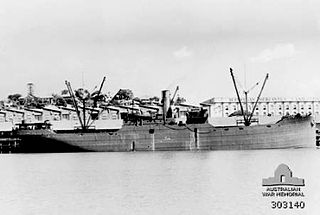
The Design 1023 ship was a steel-hulled cargo ship design approved for mass production by the United States Shipping Board's (USSB) Emergency Fleet Corporation (EFC) in World War I. Like many of the early designs approved by the EFC, the Design 1023 did not originate with the EFC itself but was based on an existing cargo ship designed by Theodore E. Ferris for the United States Shipping Board (USSB). The ships, to be built by the Submarine Boat Corporation of Newark, New Jersey, were the first to be constructed under a standardized production system worked out by Ferris and approved by the USSB.
SSCambridge was a Design 1023 cargo ship built for the United States Shipping Board immediately after World War I.

The Design 1029 ship was a steel-hulled passenger/cargo ship designed to be converted in times of war to a troopship. design approved for production by the United States Shipping Board's Emergency Fleet Corporation (EFT) in World War I. They were referred to as the 535-type as all the ships were 535 feet overall length. A total of 10 ships were ordered and built from 1921 to 1922. An additional six ships, originally contracted as Design 1095 ships, were changed during building so they were identical to the Design 1029 ships. Three shipyards built the ships: Bethlehem Sparrows Point Shipyard of Baltimore, Maryland ; Newport News Shipbuilding & Drydock Company of Newport News, Virginia ; and New York Shipbuilding Company of Camden, New Jersey.
SS Gunston Hall was a Design 1015 steel-hulled cargo ship built in 1919 by the Virginia Shipbuilding Company for the United States Shipping Board's Emergency Fleet Corporation. Initially intended for service in World War I, Gunston Hall was not completed until after the war's end. The ship was sold for scrap in 1930.

